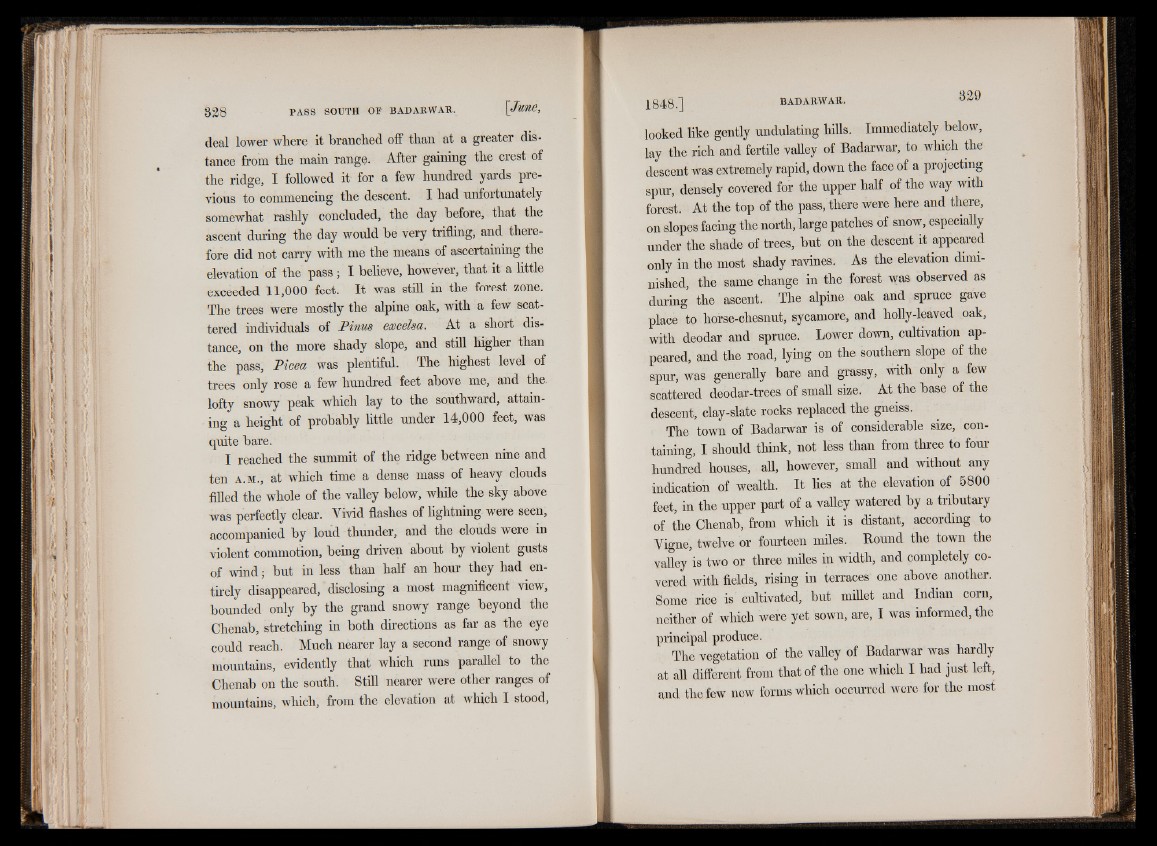
deal lower where it branched off than at a greater distance
from the main range. After gaining the crest of
the ridge, I followed it for a few hundred yards previous
to commencing the descent. I had unfortunately
somewhat rashly concluded, the day before, that the
ascent during the day would be very trifling, and therefore
did not carry with me the means of ascertaining the
elevation of the pass ; I believe, however, that it a little
exceeded 11,000 feet. It was still in the forest zone.
The trees were mostly the alpine oak, with a few scattered
individuals of Pirns excelsa. At a short distance,
on the more shady slope, and still higher than
the pass, Picea was plentiful. The highest level of
trees only rose a few hundred feet above me, and the
lofty snowy peak which lay to the southward, attaining
a height of probably little under 14,000 feet, was
quite bare.
I reached the summit of the ridge between nine and
ten a .m ., at which time a dense mass of heavy clouds
filled the whole of the valley below, while the sky above
was perfectly clear. Vivid flashes of lightning were seen,
accompanied by loud thunder, and the clouds were in
violent commotion, being driven about by violent gusts
of wind; but in less than half an hour they had entirely
disappeared, disclosing a most magnificent view,
bounded only by the grand snowy range beyond the
Chenab, stretching in both directions as far as the eye
could reach. Much nearer lay a second range of snowy
mountains, evidently that which runs parallel to the
Chenab on the south. Still nearer were other ranges of
mountains, which, from the elevation at which I stood,
looked like gently undulating hills. Immediately below,
lay the rich and fertile valley of Badarwar, to which the
descent was extremely rapid, down the face of a projecting
spur, densely covered for the upper half of the way with
forest. At the top of the pass, there were here and there,
on slopes facing the north, large patches of snow, especially
under the shade of trees, but on the descent it appeared
only in the most shady ravines. As the elevation diminished,
the same change in the forest was observed as
during the ascent. The alpine oak and spruce gave
place to horse-chesnut, sycamore, and holly-leaved oak,
with deodar and spruce. Lower down, cultivation appeared,
and the road, lying on the southern slope of the
spur, was generally bare and grassy, with only a few
scattered deodar-trees of small size. At the base of the
descent, clay-slate rocks replaced the gneiss.
The town of Badarwar is of considerable size, containing,
I should think, not less than from three to four
hundred houses, all, however, small and without any
indication of wealth. It lies at the elevation of 5800
feet, in the upper part of a valley watered by a tributary
of the Chenab, from which it is distant, according to
Vigne, twelve or fourteen miles. Bound the town the
valley is two or three miles in width, and completely covered
with fields, rising in terraces one above another.
Some rice is cultivated, but millet and Indian corn,
neither of which were yet sown, are, I was informed, the
principal produce.
The vegetation of the valley of Badarwar was hardly
at all different from that of the one which I had just left,
and the few new forms which occurred were for the most